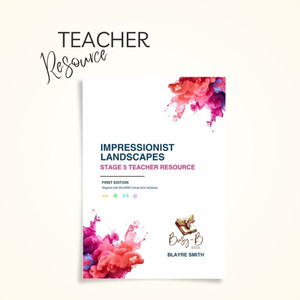
his Impressionist Landscape Unit of Work offers a comprehensive and engaging approach to teaching the art movement of Impressionism, specifically focusing on Claude Monet’s innovative techniques in capturing light, colour, and atmosphere. The unit is aligned with the NSW Stage 5 Visual Arts syllabus and integrates Aboriginal pedagogy to create a culturally responsive and student-centered learning environment. Teachers will find da detailed unit of work for 10 learning weeks with an additional week of extension activities designed to help students connect with the subject matter or continue learning for an 11 week term. The unit also includes an innovative multimedia project where students create a time-lapse video, capturing the effects of the Earth's movement around the sun, and write a poem to voice over their video.
Key Features for Teachers
- Aligned with the new NSW Syllabus: Addresses Stage 5 Visual Arts syllabus outcomes, providing clear learning intentions and success criteria.
- Step-by-Step Guidance: Clear instructions on how to introduce Impressionism, guide students through techniques, and incorporate reflective practice. Utilising the Gradual Release of Responsibility Model.
- Cross-Curricular Opportunities: Provides connections with Science (exploring the Earth’s movement), English (writing poems), Geography (landscapes) and Media (creating videos), encouraging a multidisciplinary approach to learning.
- Technology Integration: Students use technology to create a time-lapse video reflecting the changing effects of the Earth's rotation, exploring light and shadow as part of their learning process. They will also create and voice over a poem that complements their video, adding a creative narrative to their artwork.
Incorporating Aboriginal Pedagogy
- Story Sharing: Students are encouraged to share their personal stories and interpretations through their artwork and poem. This promotes a sense of ownership and deepens their connection to the subject matter.
- Deconstruct and Reconstruct: The unit allows students to break down complex ideas about Impressionism and reconstruct them through their own creative expression. They are encouraged to question traditional artistic representations and explore new ways of seeing the world, much like the Impressionist movement itself.
- Land Links: Students explore natural landscapes for inspiration, drawing connections between the physical environment and their art, much like Monet’s connection to nature. These links foster a deeper appreciation for the world around them and help students express their observations through their work.
- Non-verbal Learning: Art creation is an inherently non-verbal form of communication, and this unit embraces the use of visual language to express understanding, emotions, and concepts. Through their paintings and the time-lapse video project, students learn to express ideas without words.
- Learning Maps: The unit encourages students to map out their creative process, tracking the development of their ideas from initial sketches to their final artwork. These learning maps help students understand the journey of their artistic growth and how they connect with the learning objectives.








